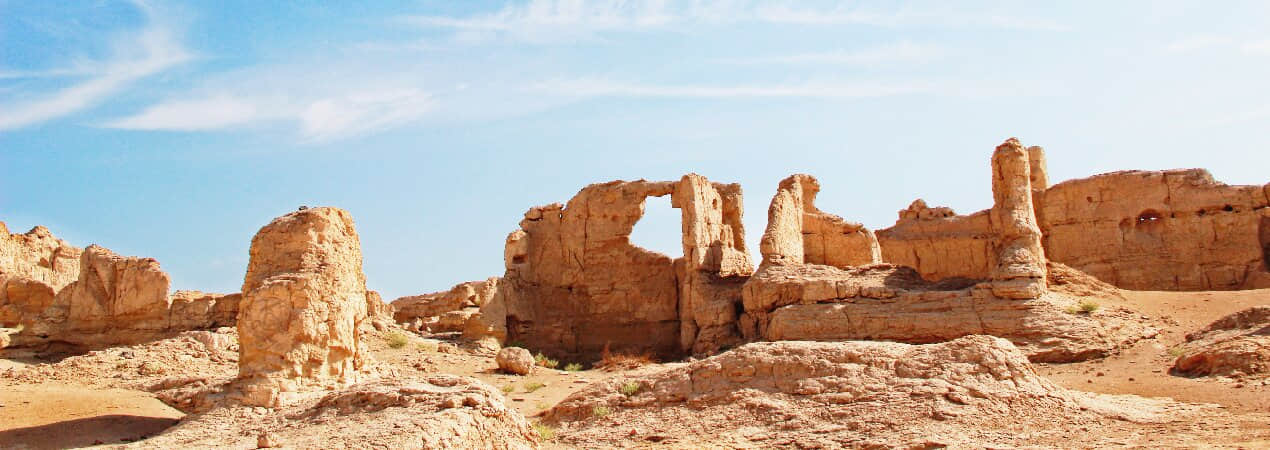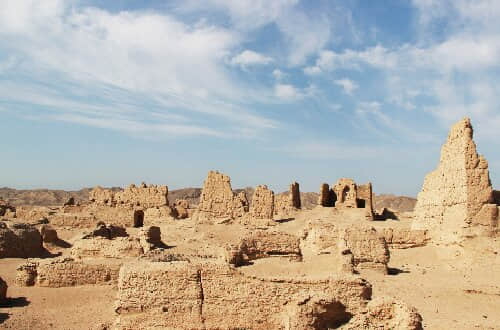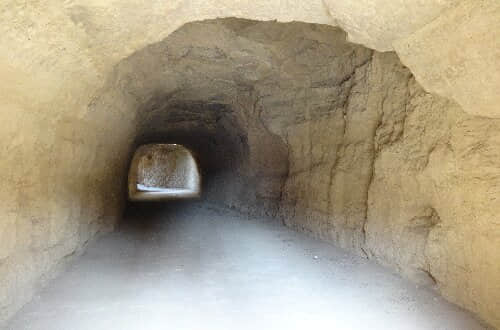Jiaohe Ruins

The Jiaohe Ruins cover a total area of 37.6 hectares with a building area of 220,000 square meters. It is the best-preserved, longest-continuously inhabited, and largest ancient earthen architectural city in the world. Historically, the Jiaohe Ruins served as an important town on the Silk Road, holding significant value in politics, culture, history and art.
- Chinese name: 交河故城 Jiāo Hé Gù Chéng
- Suggested time: 2 - 3 hours
- Ticket: 70 yuan per adult
- Open hours: 10:00 - 19:30
- The best time to visit: Spring (March - May) and autumn (September - November)
- Address: Located in Yare Township, Gaochang District, Turpan City, Xinjiang Uygur Autonomous Region. It's about 10 kilometers west of Turpan city proper.
- How to get there: It's very convenient to drive by yourself.
Highlights of Jiaohe Ruins
Buddhist Temples
 Grand Buddhist Temple
Grand Buddhist TempleIn the Jiaohe Ruins, there are the Grand Buddhist Temple, the Northeast Buddhist Temple, and the Northwest Buddhist Temple. The Grand Buddhist Temple features a rectangular layout, covering an area of over 5,000 square meters. Composed of a temple gate, bell tower, well, monastic quarters, and main hall, it was the largest Buddhist temple in Jiaohe City. Today, architectural remains such as the main hall, pagoda, and well still remain within the temple. Notably, the center of the main hall preserves a square pagoda pillar with niches on all four sides, where traces of Buddha statues can still be seen. Past the Grand Buddhist Temple, a fork in the path leads to the Northwest and Northeast Buddhist Temples respectively.
The Northwest Small Temple, built around the 4th century AD, is the best-preserved among the Buddhist temple ruins in Jiaohe. The Northeast Small Temple is a distinctive Buddhist monastery with its gate facing south. In front of the temple, two square architectural remains on either side may be the ruins of pagodas or the foundations of a bell tower and a drum tower. A passage between the two structures leads directly to the main hall, where a pagoda pillar is chiseled at the center. The pillar has niches on all four sides that originally housed statues of the Four Directional Buddhas. The main hall connects to a spacious backyard, likely used as a venue for eminent monks to deliver sermons.
Pagoda Forest
To the north of the Northeast Buddhist Temple lies the Pagoda Forest of the Jiaohe Ruins. Aerial views reveal that the forest is composed of a Vajrasana-style central pagoda and four groups of smaller pagodas arranged in the four cardinal directions. At its core stands an 8-meter-tall grand pagoda, with 25 uniformly shaped smaller pagodas—five rows in both horizontal and vertical directions at each of the four corners—forming a complex of 101 pagodas in total. In the late 19th to early 20th centuries, foreign explorers discovered sarira (Buddhist relics) of eminent monks here, confirming that this imposing pagoda forest served as a burial site for revered monks.
Government Office Area
 Underground Passage of Government Office Area
Underground Passage of Government Office AreaThe last attraction of the Jiaohe ruins is the Government Office Area. Located underground, the main building covers nearly 8,000 square meters, and together with ancillary buildings and the plaza, it covers an area of 20,000 square meters, making it the most magnificent architectural complex in the city. The ruins of the Government Office Area feature not only open and hidden passages connected to the main thoroughfares of the ancient city, but also grand architectural scale and an imposing underground courtyard.
The government offices were built underground due to Turpan's climate—scorching summers and freezing winters. Designed to escape the heat and cold, this underground layout ensures a cool summer and warm winter, perfectly adapted to local climatic conditions.
Educational Value
The Jiaohe Ruins preserve over 1,300 residential site remains, 53 Buddhist temple ruins, 316 ancient wells, a 1,900-meter main street, and 34 alleyways. Its architectural techniques are unique. Most central structures in the ancient city were excavated from the original soil—by cutting the native earth to leave four walls, then roofing with wood. This design method of "carving buildings from the earth, ramming soil into walls, and leveling roads by excavation" is unparalleled at home and abroad, and stands as one of the world's most eco-friendly and energy-efficient architectural forms. Visiting this magical ruin allows us to understand the architectural wisdom of the ancients.
Activities to do at Jiaohe ruins
Ruins Sketching: The architectural techniques of Jiaohe ruins are unique. You can demarcate a safe area and use the loess ruins and street patterns of Jiaohe Ancient City as creative materials for artistic creation.
Photography Creation: Observe the light and shadow variations of Jiaohe ruins at different times, and capture the "beauty of ruins" and the sense of historical vicissitudes.
Drop us a line and we'll connect you with the top China expert in no time!